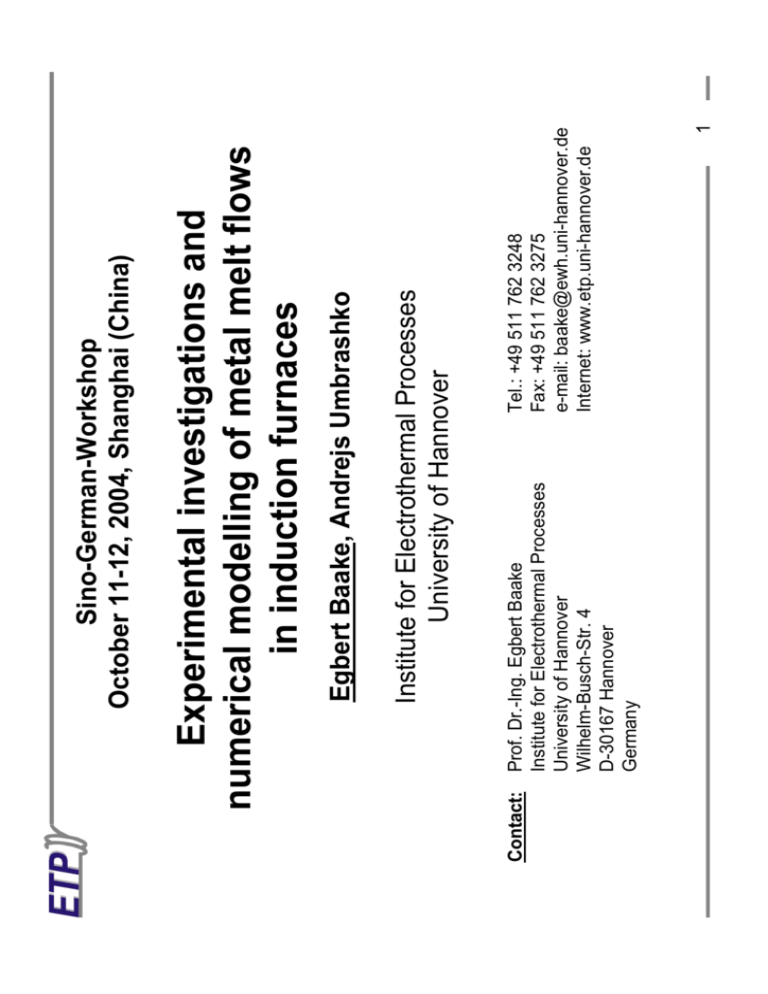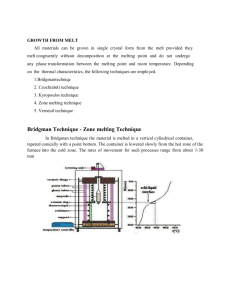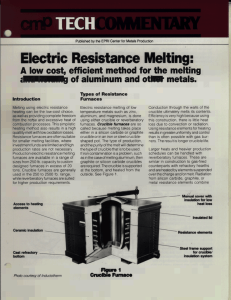Experimental investigations and numerical modelling of
advertisement

Contact: Prof. Dr.-Ing. Egbert Baake Institute for Electrothermal Processes University of Hannover Wilhelm-Busch-Str. 4 D-30167 Hannover Germany 1 Tel.: +49 511 762 3248 Fax: +49 511 762 3275 e-mail: baake@ewh.uni-hannover.de Internet: www.etp.uni-hannover.de Institute for Electrothermal Processes University of Hannover Egbert Baake, Andrejs Umbrashko Experimental investigations and numerical modelling of metal melt flows in induction furnaces Sino-German-Workshop October 11-12, 2004, Shanghai (China) Conclusions - experimental work - 3D tansient numerical simulation Melt flow in cold crucible furnace - low frequency oscillations - 3D flow structure Introduction Characteristics of turbulent metal melt flow in induction furnaces Contents 2 and mass exchange in the melt ¬ Optimisation of the heat y Intensive stirring for cleaning of the melt (zinc removing) y Avoiding of erosion and clogging of the ceramic lining y Avoiding of melt instabilities, splashing or pinching y Intensive stirring at the melt surface (melting of small-sized scrap, carburization process) y Homogenisation of the temperature, avoiding of local overheating , but realizing of sufficient superheating of the entire melt y Mixing and homogenisation of the entire melt Industrial process requirements for melting in induction furnaces 3 Optimal design and optimisation of the operation behaviour of induction furnaces needs 3D instationary numerical simulation of the turbulent melt flow and the heat and mass transfer using experimentally verified models 4 Experimental investigations, e.g. measurements of the turbulent melt flows are very limited in industrial furnaces, experimental investigations are possible in model furnaces with model melts Heat and mass transfer and the temperature distribution in the melt are determined by 3D instationary turbulent melt flows Main features of the induction furnace metal melting processes liquid-solid-interface skull - superheating - heat flow - crucible temperature temperature field geometry of melt meniscus shape 5 optimization of design and operating parameters homogenisation of melt velocity field - distribution of power - el. efficiency magnetic field Physical Correlations Baake, E. et.al.: 1994 Crucible bottom Vmax ≈ 20 cm/s Crucible wall v′max ≈1 vmax 6 Melt flow measurements in induction crucible furnace 15 20 25 -25 -20 -15 -10 -5 0 5 10 Geschwindigkeit in cm/s 0 20 30 Zeit in s 40 ¬ Low-frequency oscillations ¬ Oscillation period: 8...12 sec 10 50 7 Measurement of local flow velocity (ICF): near the crucible wall between the main flow eddies crucible bottom crucible wall Calculation results of turbulent characteristics are different from measurement results 8 Application of 2D and 3D RANS (k-ε) turbulence models: •Simulations •Simulationsof ofindustrial industrialinstallations installations are impossible are impossible ••Steady-state Steady-statesimulations simulations ••Transient Transient3D 3Dsimulations simulations ••Relatively Relativelyhigh highmesh meshresolution resolutionrequirements requirements LES LES ••Large Largescales scalesare areresolved resolveddirectly directlywhile whileonly onlysmall small scales scalesare aremodelled modelled 4 Re Re≥≥10 104 9 ••Very Veryhigh highrequirements requirementsfor for computational resources computational resources ••Relatively Relativelylow lowmesh meshresolution resolution requirements requirements CFD CFDproblem problem DNS DNS ••All Allscales scalesare areresolved resolveddirectly directly RANS RANS(k-ε (k-εmodel) model) ••Whole Wholeenergy energyspectrum spectrumisismodelled modelled 0 0,05 0,1 0,15 0,2 0,25 -0,25 -0,2 -0,15 -0,1 -0,05 Geschwindigkeit in m/s 0 10 Zeit in s 30 40 50 60 ¬ Low-frequency oscillations ¬ Oscillation period: appr. 10 sec 20 r = 0.075 r = 0.14 r = 0.155 Calculated local flow velocity: (3D transient LES) 10 Amplitude Measurement Frequency (Hz) Calculation Fourier analysis of the measured and calculated oscillations of the axial velocity components near the crucible wall between the main flow eddies 11 velocity magnitude azimuthal velocity 12 particles trajectories Long-time period averaged velocity field in the melt of the ICF (3D transient LES) Filling level 90 % Rcr = 0.49 m Hind = 1.33 m P = 4540 KW 3D hydrodynamic model of an industrial induction crucible furnace 13 Experiment (model furnace) Calculations (industrial furnace) Kinetic energy of the oscillations 14 Time-averaged flow pattern [m/s] 15 Transient flow development [m/s] 16 Transient flow development (cross-section) [m/s] 17 Calculation of the particle tracing in the melt of the ICF (3D transient LES) 18 (water cooled) bottom melt with meniscus shape current (water cooled inductor (water cooled) crucible segment slit melt flow radiation heat conduction skull EM-forces 19 heat losses by radiation and conduction depending on the meniscus shape water cooled bottom and crucible segments leads to solid layer (skull) free melt surface, based on electromagnetic forces slitted crucible to realize efficient electromagnetic transparency Features of the Induction Furnace with Cold Crucible crucible-bottom bottom-skull wall-skull contact point ideal free surface real inductor crucible Reliable, reproducible and stable melting process 20 Improvement of the total efficiency of process Maximisation of the overheating temperature, which is the key parameter of the process Optimisation of electromagnetic and thermal parameters Cold crucible induction furnace TT==660-720°C 660-720°C PP==200 200kW kW ff==9.2 9.2kHz kHz 55coil coilturns turns i RRc ==72.5 72.5mm mm c HHi ==208 208mm mm Experimental set-up for semi-levitation melting 21 Melting process of Aluminium 22 Temperature measurements in Aluminium 23 Measured temperature field in Aluminium 24 electrodes magnet core coil 35 stainlesssteel case stainlesssteel holder 6 14 Melt flow measurements in Aluminium with the electromagnetic velocity probe 25 Flow pattern and temperature distribution simulated with 2D RNG k-ε turbulence model 26 *HLRN – scientific supercomputer network of North Germany 27 Parallel Parallel computations computations with with FLUENT FLUENT 6.1 6.1 software software at at the the HLRN*-system HLRN*-system Smagorinsky-Lilly Smagorinsky-Lilly subgrid subgrid viscosity viscosity model model Time Time step step 10 10 ms ms 6 ~3.8•10 ~3.8•106 elements elements 3D LES-model for Aluminium melting vm~40 cm/s Time-averaged Time-averagedflow flowpattern pattern [m/s] 28 An Anintermediate intermediateflow flowpattern pattern [m/s] Results of 3D transient LES modeling Results of 3D transient LES modeling 29 Time-averaged Time-averagedtemperature temperature distribution distribution ºC Measured Measuredtemperature temperature distribution distribution ºC Results of 3D transient LES modelling 30 Results of 3D transient LES modelling 31 Results of 3D transient LES modelling 32 33 3D-transient LES is a reliable numerical tool to simulate the turbulent melt flow with in-stationary low-frequency flow oscillations in induction melting installations Comparison of the LES modelling results with experimental results show good agreement Heat and mass transfer processes in the melt of induction furnaces are significantly influenced by large scale low-frequency oscillations of the recirculating flow main eddies Conclusions







